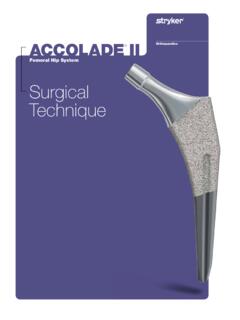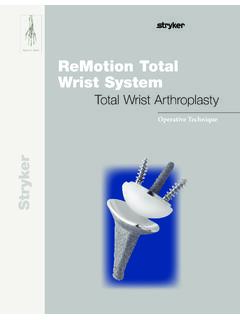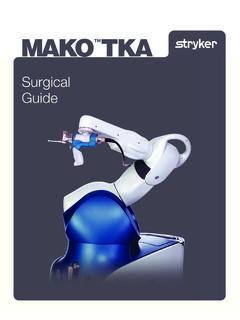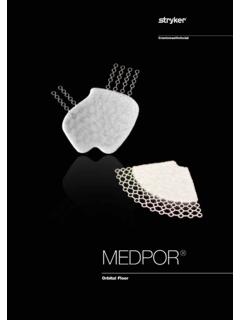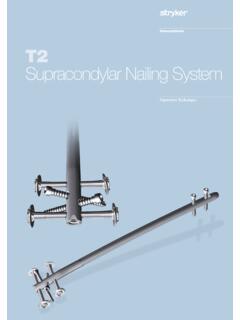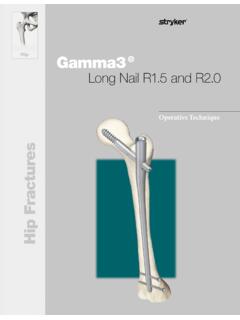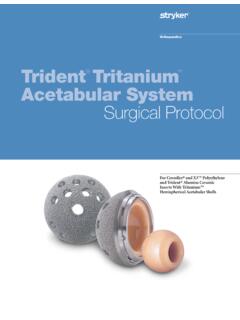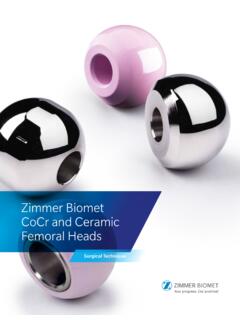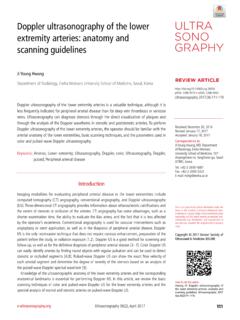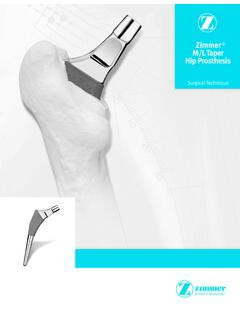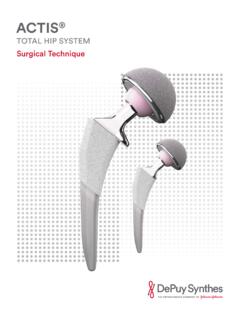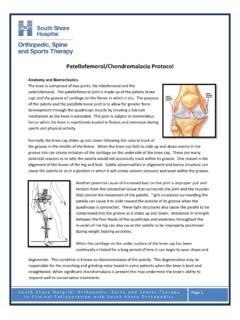Transcription of Table of Contents - Stryker MedEd
1 Exeter V40 femoral Stem Table of Contents Indications Indications and IFC The indications for use in total hip arthroplasty include: Surgical Protocol Non-inflammatory degenerative joint disease, including osteoarthritis and avascular necrosis. Step 1 - Pre-Operative Planning and X-ray 1. Rheumatoid arthritis. Step 2 - Surgical Exposure .. 2. Step 3 - femoral Neck Resection .. 2 Correction of functional deformity. Step 4 - femoral Preparation .. 3 Revision procedures where other treatments or devices have failed. Step 5 - femoral Broaching .. 4. Treatment of non-unions, femoral neck fractures and Step 6 - Trial 5. trochanteric fractures of the proximal femur with head Step 7 -Further femoral Preparation.
2 6 involvement that are not manageable using other Step 8 - femoral 7 techniques. Step 9 - Stem 8. Step 10 - Stem Insertion (continued) .. 9 Contraindications Step 11 -Reduction .. 10 Active infection or suspected latent infection in or about the Step 12 - Post-Operative 10 hip joint. Step 13 - Follow 10 Bone stock that is inadequate for support or fixation of the Catalog Information prosthesis. Implant & Instrument Listing .. 11 Skeletal immature. Instrument Listing .. 14 Any mental or neuromuscular disorder that would create an unacceptable risk of prosthesis instability, prosthesis fixation failure, or complications in postoperative care. Warnings and Precautions See implant package insert for warnings, precautions, adverse effects and other essential product information.
3 Before using instrumentation, verify: Instruments have been properly disassembled prior to cleaning and sterilization Instruments have been properly assembled post sterilization Instruments have maintained design integrity Proper size configuration is available For instructions for Cleaning, Sterilization, Inspection and Maintenance of Orthopaedic Medical Devices, refer to LSTPI-B. This publication sets forth detailed recommended procedures for using Stryker Orthopaedics devices and instruments. It offers guidance that you should heed, but, as with any such technical guide, each surgeon must consider the particular needs of each patient and make appropriate adjustments when and as required. STEP 1.
4 PRE-OPERATIVE PLANNING AND X-RAY EVALUATION. Pre-operative planning is an essential part of the leg length and any adjustment that may be required. The procedure and templating should be performed prior to correct centre of rotation for the acetabular and femoral every case. When it is done using x-rays that have been components should be established and this will include suitably scaled for magnification, templating allows the measurement of the patient's existing femoral offset, surgeon to predict the size and offset of the implant that which will need to be replicated. will restore the correct anatomy of the individual patient. The appropriate stem size for the patient can be judged Planning the positions of the cup and stem will also help from the templates, using the lines marked alongside the the surgeon place each component at the correct centre stem profile.
5 The set of lines closest to the stem profile of rotation and thereby restore the correct leg length. indicates the minimum necessary cement mantle and Pre-operative planning can be done using acetate when placed on the patients X-rays they should lie within templates for printed radiographs or pre-operative the femoral canal. It is important to remember that using planning software for digital studies (Figure 1). It should an excessively large femoral stem may compromise the start with an assessment of the magnification of the cement mantle, but an excessively small stem may be at radiograph and adjustment for that if necessary. The risk of fracture. surgeon should then take account of the pre-operative Figure 1.
6 1. STEP 2. SURGICAL EXPOSURE. The Exeter stem can be implanted through the commonly used surgical approaches to the hip including the direct lateral approach and the posterior approach, which is featured in this technique manual. Whichever approach is used, a full exposure of both the acetabulum and the proximal femur, with appropriate soft tissue releases, is essential for effective preparation of the bony cavities, cementing and implant insertion (Figure 2). Figure 2. STEP 3. femoral NECK RESECTION. The level and orientation of neck resection are not critical for the Exeter Hip stem because it has no collar or other features that would affect the position of the osteotomy. However, there should be adequate proximal support for the stem, guidance for which is given by the three markings on the femoral prosthesis.
7 It is advised that the neck osteotomy is not made so low as to leave all three markings proud of the cement mantle. In most individuals an appropriate level of neck resection lies along a line drawn from a point medially mid-way B. between the upper margin of the lesser trochanter and the inferior aspect of the head (Figure 3 point A), to a point A. laterally at the base of the neck (Figure 3 point B). Figure 3. 2 EXETER V40 femoral STEM SURGICAL TECHNIQUE. STEP 4. femoral PREPARATION. The leg is placed in a position that enables the surgeon to achieve straight-line access down the length of the femoral shaft and sufficient soft tissue clearance for stem ante- version. Use of a gluteus medius retractor may help to expose the lateral aspect of the cut femoral neck, which is important for straight-line access to the femoral canal.
8 The use of one or more femoral elevators will help to deliver the femur out of the wound, providing clearance of the soft tissues, which allows the surgeon to control the degree of anteversion of the femoral component (Figure 4). The medullary canal is opened using a hollow box chisel or a straight gouge, undercutting the lateral cortex of the neck, and developing a slot into the trochanteric region (Figure 5). If necessary, a rongeur is used after undercutting of the neck, to resect the lateral-most Figure 4. cortical bone of the neck. The tapered pin reamer is introduced into the femoral canal, in line with the long axis of the femur, which helps to ensure that the femoral stem can be inserted down the midline of the femur (Figure 6).
9 To achieve this, the surgeon may rotate the handle of the tapered pin reamer whilst applying a moderate valgus force to the handle, which removes any remnants of the lateral neck cortex that would otherwise tend to force the stem into a varus position. The surgeon then uses the Exeter broaches to prepare the cancellous bone for aim is to preserve 2-3 mm of strong cancellous bone circumferentially around the stem cavity, into which the cement will be pressurized. Each broach is slightly larger than the corresponding stem and creates a cavity that will hold the stem with a complete cement mantle around it. Figure 5 Figure 6. Hollow Chisel Exeter Tapered Pin Reamer 4842-3012 Large and Small Small = 0932-0-000.
10 Large = 0932-2-000. 3. STEP 5. femoral BROACHING. The Exeter V40 System features modular broaches and an easy to use offset broach handle. Broaching usually begins with a smaller broach than that anticipated for final size. The last broach corresponds to the size templated as appropriate for the femur. Broaching is intended to create a cavity which will hold the stem with a complete cement mantle around it. Care should be taken when broaching the canal to avoid removal of too much cancellous bone. This cancellous bone is important for proximal support of the stem because it forms the bed into which the cement is pressurized. A calcar planer may be used if the broach is countersunk. The surgeon should start with a broach that is one or two sizes smaller than the anticipated stem size predicted by pre-operative broach is inserted along the long axis of the femur (Figure 7) to the level at which templating has shown the leg length will be restored.
